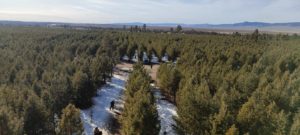
Sustainable Forest Management in Mongolia
For the past 21 months, FCG together with Mongolian Forest Research Association (MFRA) has been supporting the Government of Mongolia in developing the framework for Sustainable Forest Management (SFM) in the country. To be specific, the task was to ‘scale-up sustainable forest management’ in the country that has total of 18 million hectares of forests, most of which consists of northern boreal forests and smaller portion of saxaul forests growing in arid and semi-arid regions in the Gobi region. For comparison, Finland’s forest cover is 22,5 million hectares, also mostly boreal forests.
What is sustainable forest management then? In short, the main objective of SFM is the improvement of the forest stand for future, which is to be reached through appropriate forest operation. SFM consists of environmental, economic, and social point of views to be taken up equally while planning and implementing forest operations. This means balancing forest utilization for economic and social benefits and forest protection for environmental (including carbon sequestration) benefits. Overall, better management of forests resources can significantly improve both the socio-economic as well as environmental benefits of the forests.
Part of the task was to make a proposal for organization structure that can govern the forest resources, from the field/operations level to the national/policy level. One of the major challenges, quoted in practically all consultations held during the assignment, has been how the forest management has been organized at the field level as a component of local government, based on political decisions and without long-term management perspective. To improve the situation, forest administration is proposed to be organized under one body, which will govern and manage state-owned forests in the framework of sustainable forest management.
The sector reform consultancy is financed by the government of Japan (the Japan Fund for Prosperous and Resilient Asia and the Pacific, JFPR) and managed by the Asian Development Bank (ADB). Progress of the work has been discussed in joint review missions, with the final review mission completed this April. The mission praised FCG and MFRA for their exceptional work as a team, despite facing significant obstacles such as sudden changes in the policy context in Mongolia. The team’s technical expertise, project management experience, flexible working approach, and strong professional relationships with MET and other important stakeholders, along with their hard work and dedication, all contributed to the success of the project. Additionally, consistent leadership and support from the Director-General of the National Forest Agency played a significant role in the achievement of the project.
While FCG’s support to the sector reform is now mostly completed, work in Mongolia continues in full speed. The Ministry has established a working group to make necessary revisions to Forest Law to set the principles of Sustainable Forest Management and elements of the new organization within the legal framework. Specialists from FCG’s local partner, MFRA, are taking part in this work. In near future, we are hoping to see the government to pilot the improved organization structure in two provinces with the highest forest cover, putting the principles of sustainable forest management in real practice.
